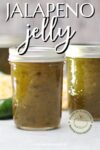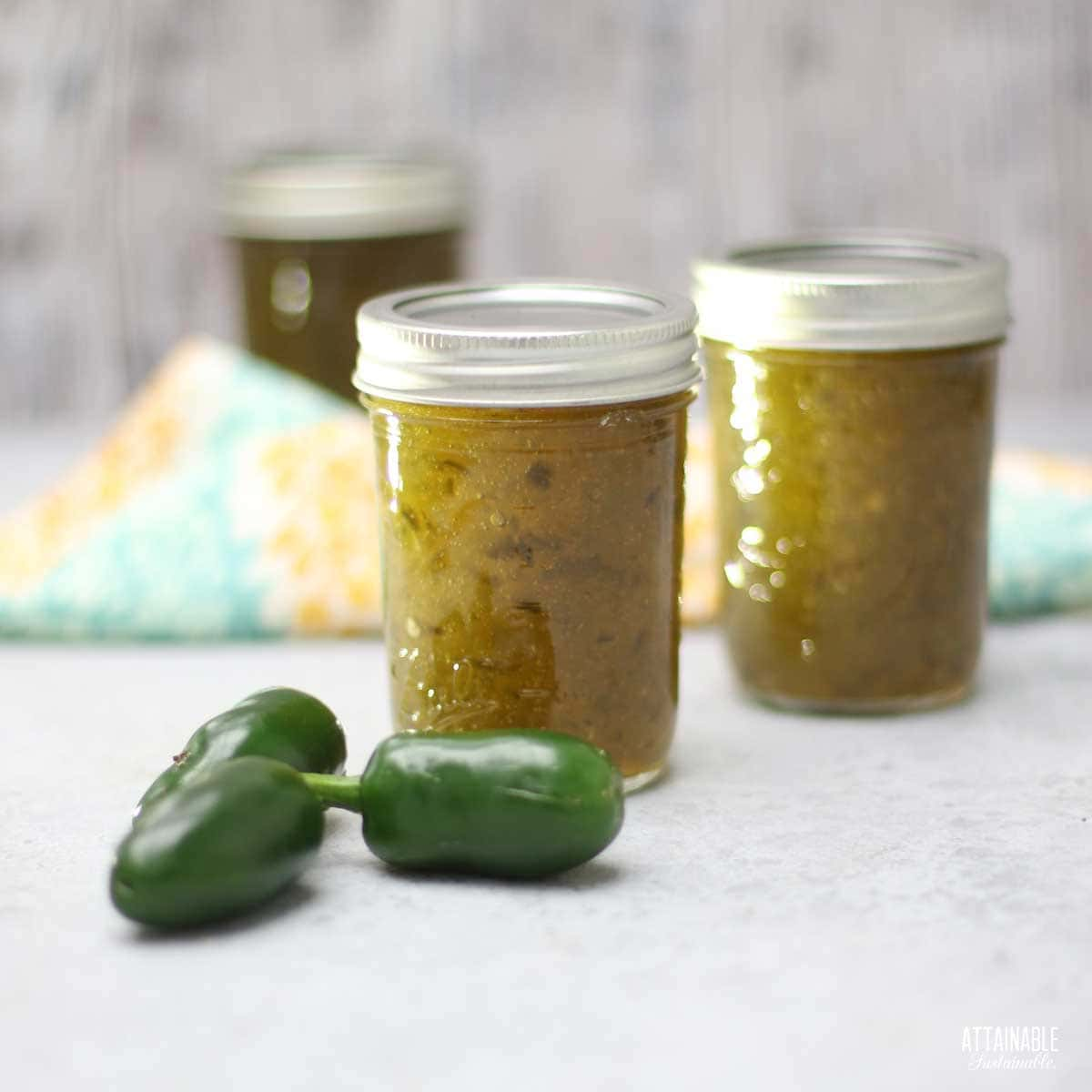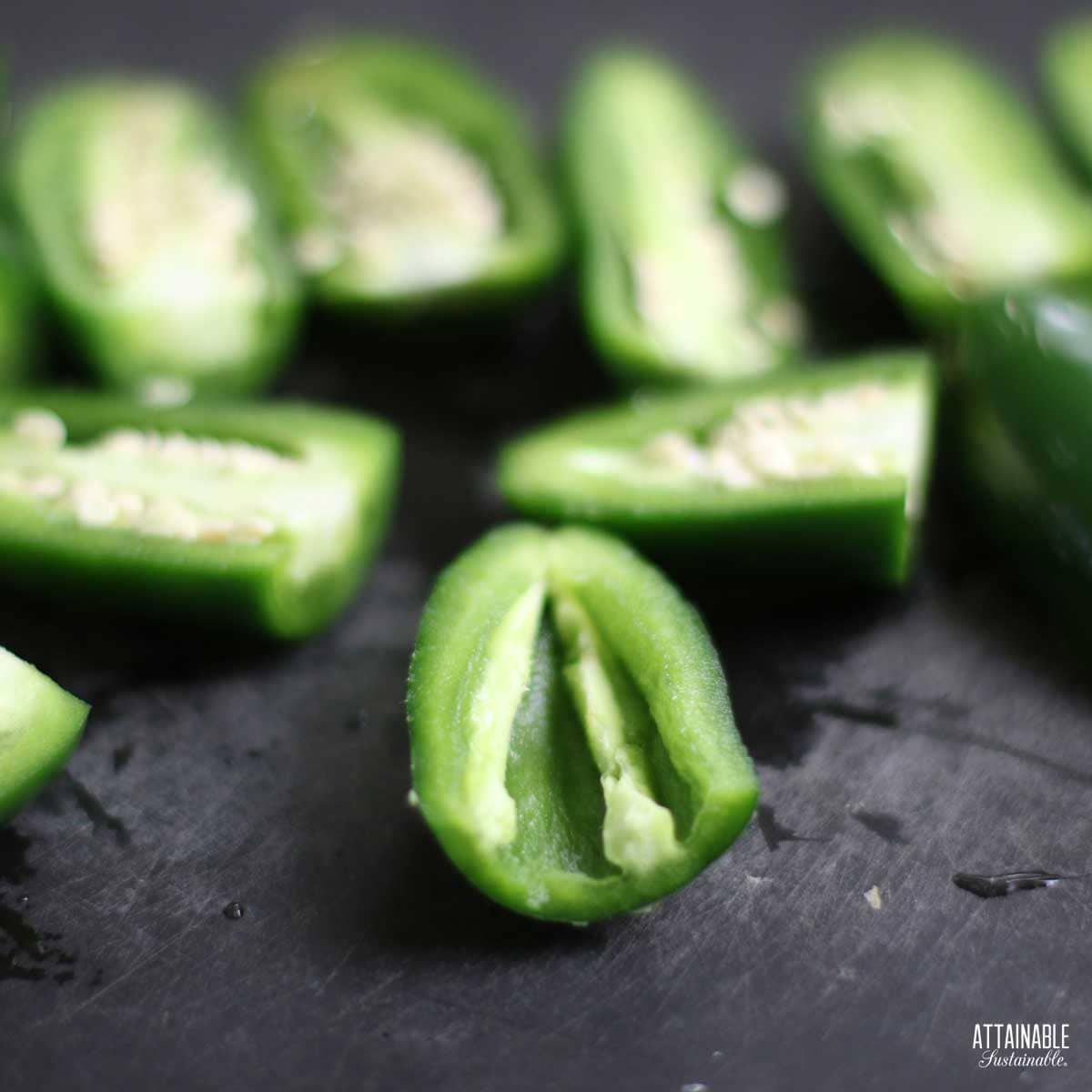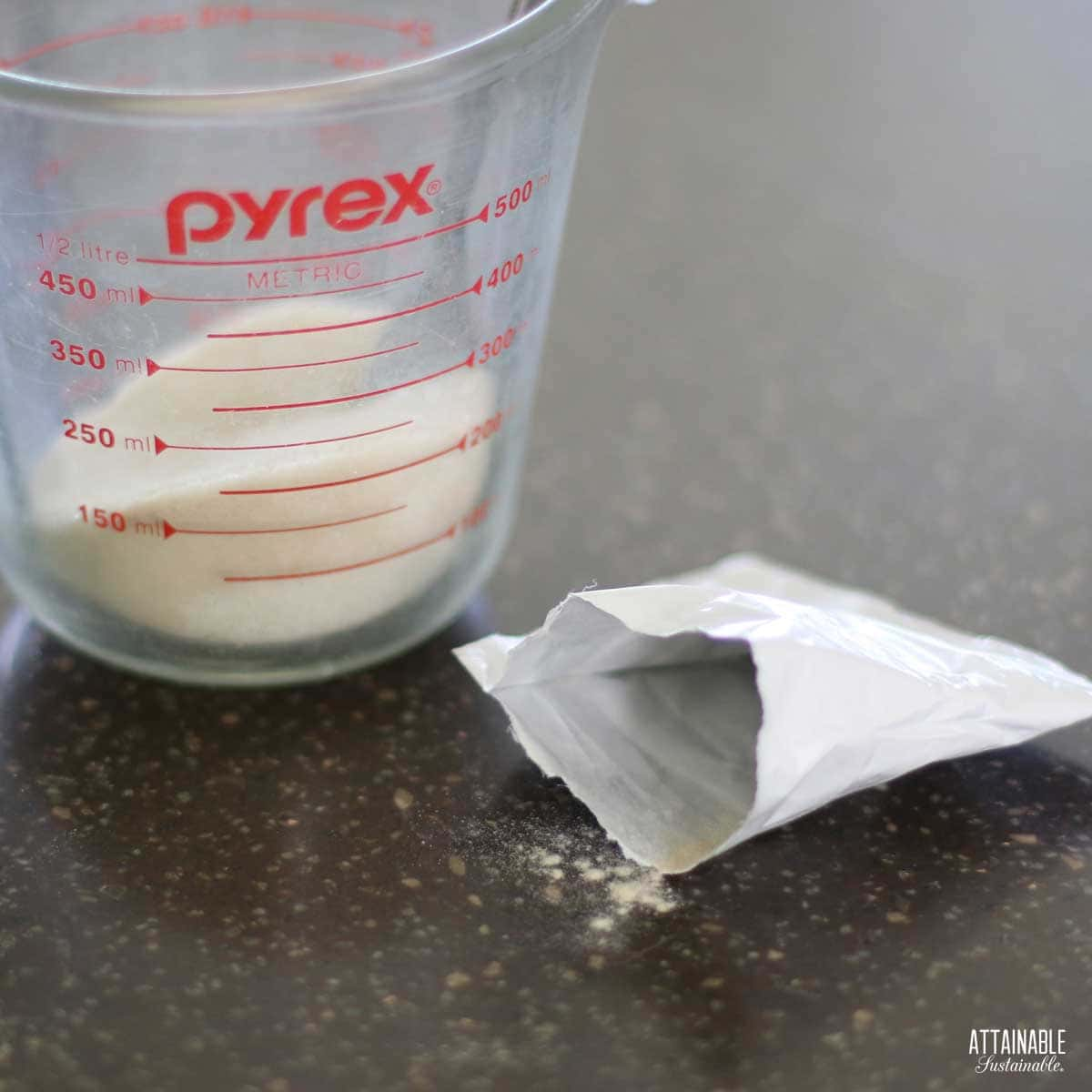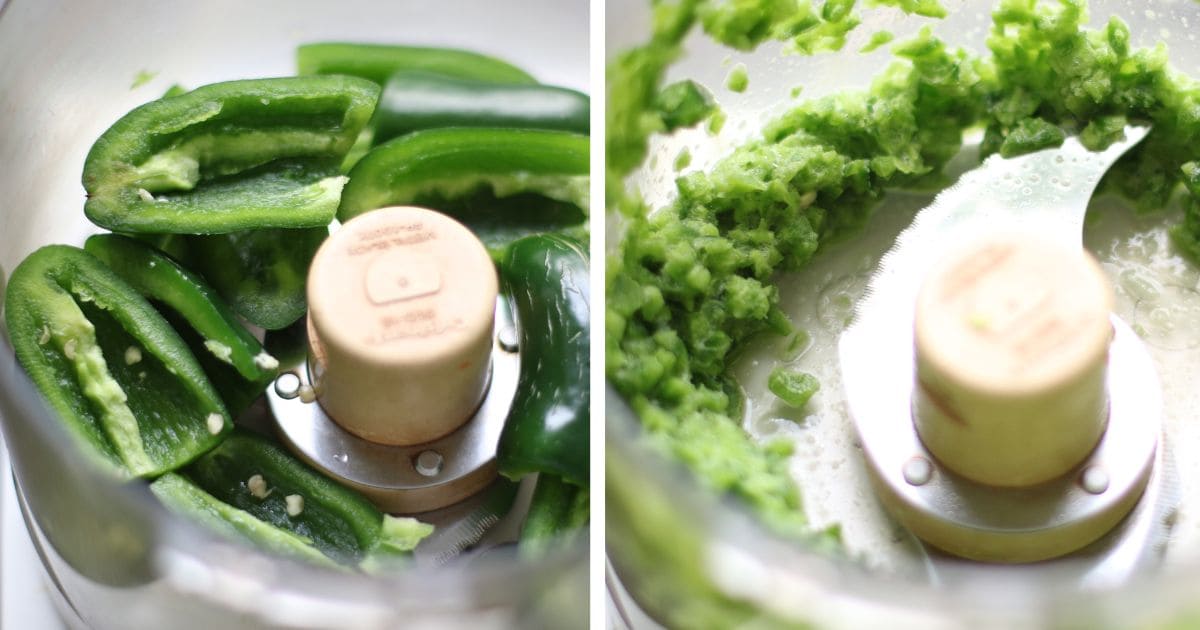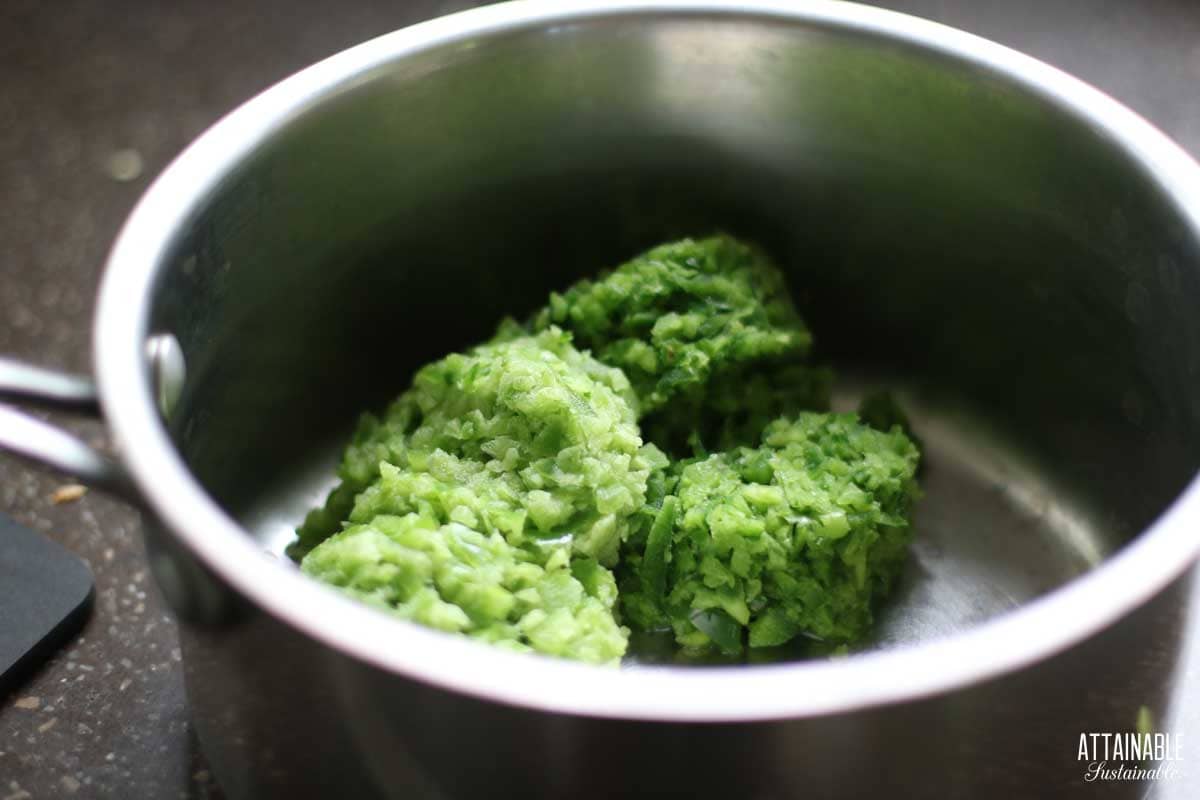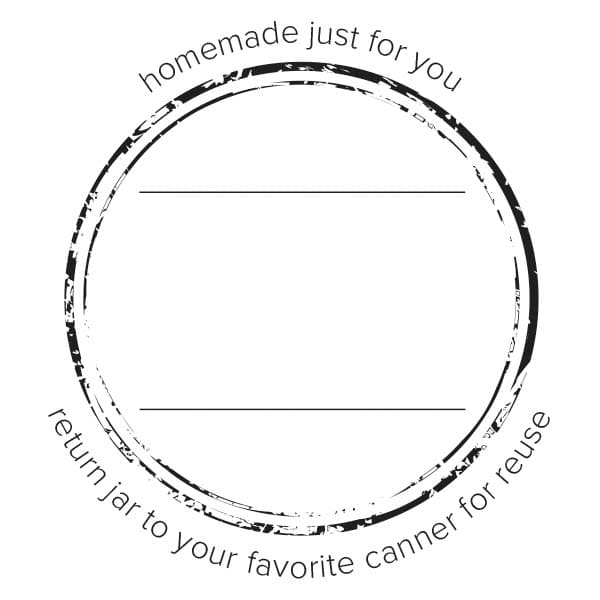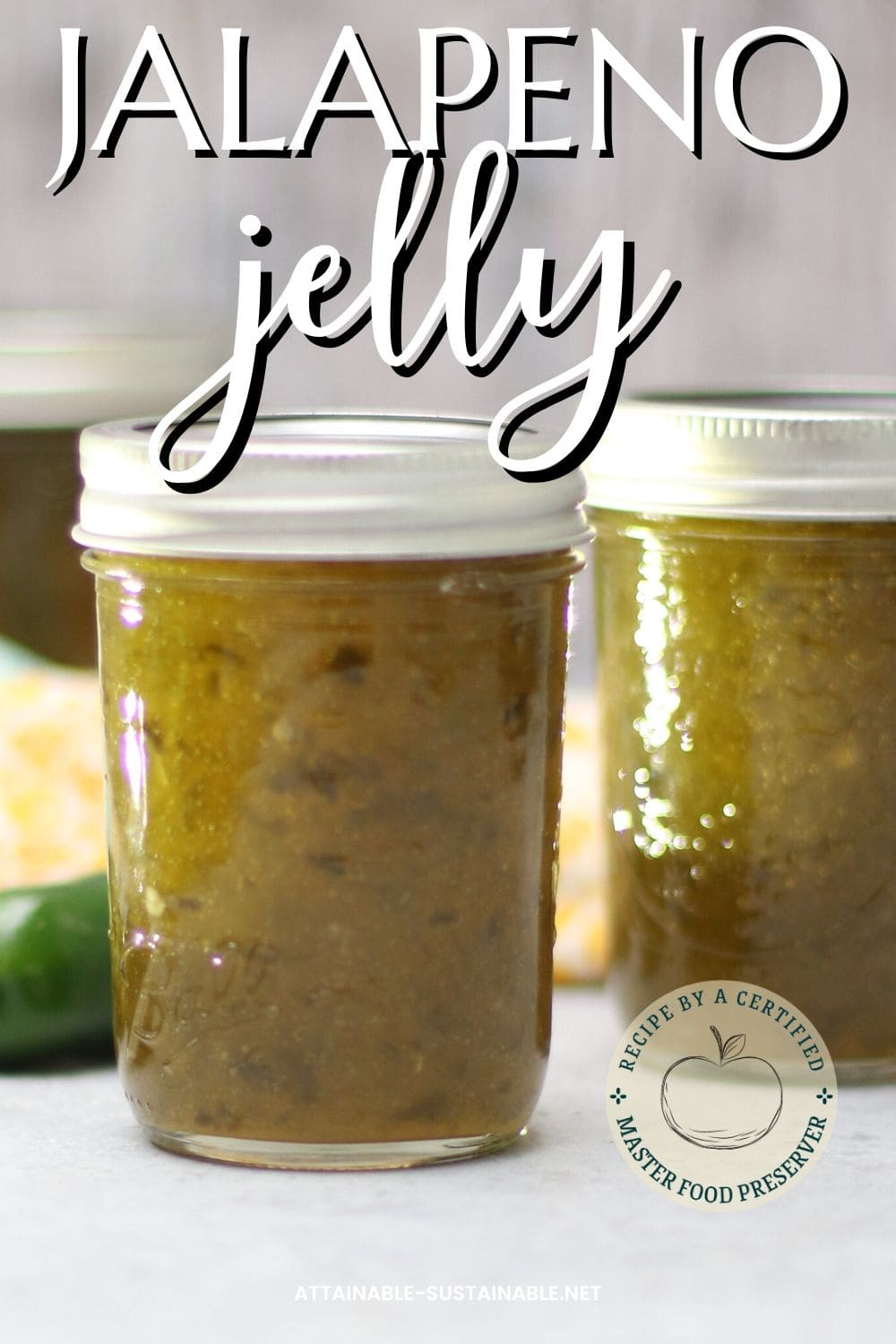This jalapeño jelly is tangy and sweet and a perfect way to preserve some of the peppers from your garden. It makes a great gift and is a favorite appetizer served with crackers and cheese.
If you’ve got plenty of peppers, be sure to try these candied jalapeños or refrigerator pickled jalapeños, too!
🌶 Jalapeño Pepper Jelly
This spicy jelly is a fun one to keep in the pantry. It can be made in 1/4 pint or half-pint mason jars, making it a good size for gift giving, too.
Ingredients
Jalapeno peppers – You’ll need a scant 1/2 pound of peppers to make this recipe. You can safely substitute any type of hot peppers for the jalapeños.
Bell peppers – You can use green peppers or red bell peppers. For this batch, I obviously opted for green. One large pepper will net the required amount.
5 Easy Steps to Transform Your Pantry!
Ready to switch from store bought to homemade? Let me help you make some changes! Grab my FREE five-part guide to getting started.
Sweetener – I used sugar for this recipe, but you can opt to use honey as well. The quantities differ a bit, so be sure to check the notes in the recipe card below.
Vinegar — Use white vinegar or apple cider vinegar, either one is fine. Be mindful of this little tidbit when buying apple cider vinegar.
Pectin – This recipe is made using Pomona’s Universal Pectin. This is the only pectin I use anymore as it allows me to use much less sweetener. The standard pectin brands and liquid pectin use an obscene amount of sugar in my opinion, often requiring equal amounts of sugar and fruit!
Making the Jelly
This recipe is for water bath canning because the resulting jalapeno pepper jelly is acidic, with a pH of about 3.0.
Start by finely dicing the peppers. You can chop peppers by hand or with the help of a food processor. Avoid over-processing; you don’t want a pepper puree!
No matter which method you use, be mindful that the jalapenos can cause skin irritation; avoid touching your face or eyes.
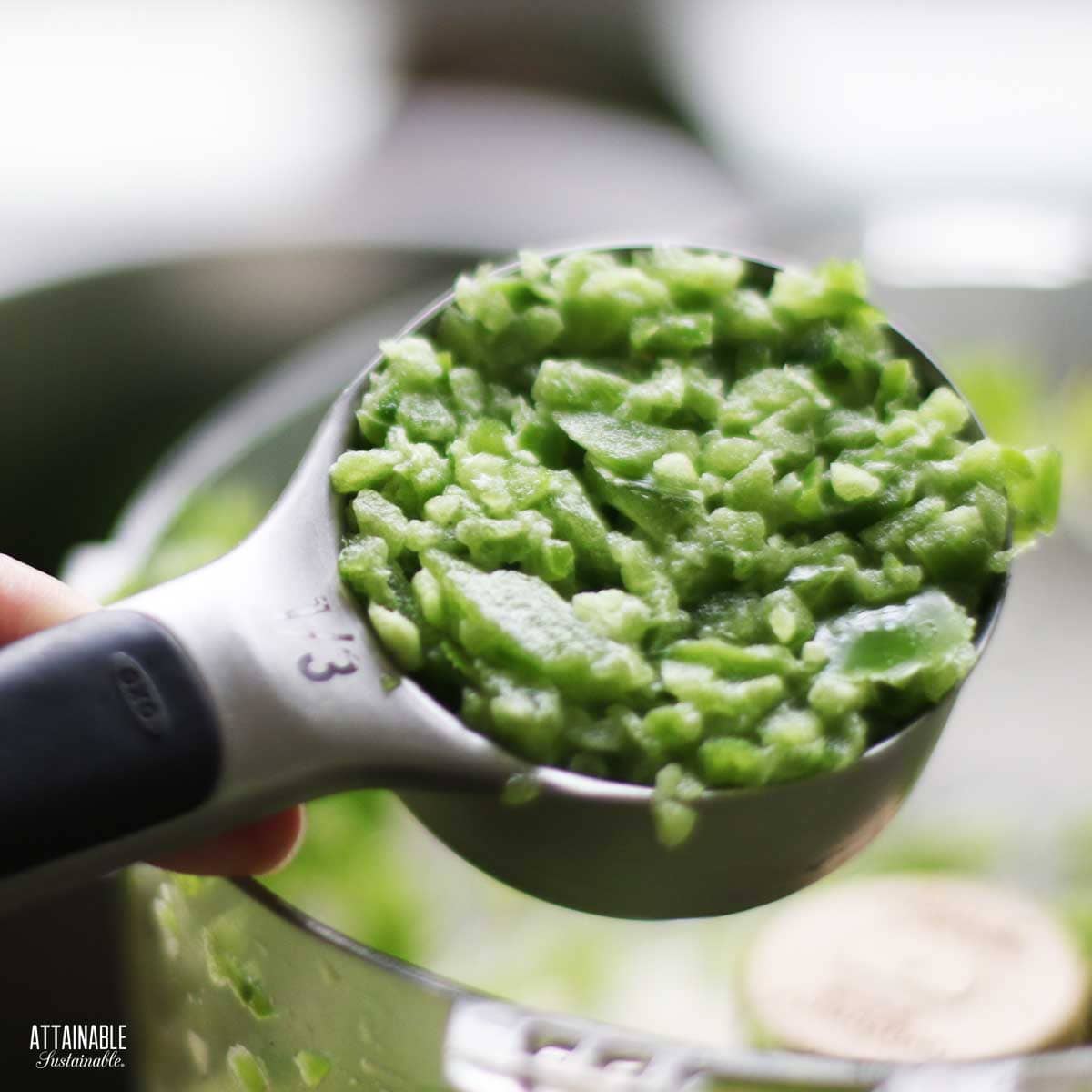
Measure hot peppers after chopping.
Combine the peppers in a large saucepan with the vinegar and cook, adding calcium water at the end of the cooking time.
Mix a portion of the sugar with the dry pectin and stir into the pepper mixture thoroughly. Once incorporated well, add the remaining sugar and return to a boil.
🍅 Safety First!
Canning is an excellent way to preserve food for the pantry, but there are some important safety considerations to keep in mind. The recipes on this site have been made following safe canning procedures by a certified Master Food Preserver.
- Know the difference between water bath canning and pressure canning. Low acid items must be pressure canned for safety.
- Altering ingredients may change the recipe’s pH, posing a safety issue. I highly recommend investing in pH paper to test your products for acidity level when canning. Note: For safe water bath canning, the Hawaii Master Food Preservers suggest a pH of 4.2 or lower in the tropics. In other regions, the recommended pH is 4.6 or lower.
- Use the proper jars and lids. Never reuse lids, with the exception of the Tattler or Harvest Right hard plastic lids that are intended for such a purpose.
- For more on canning equipment, please go here.
- Want to learn more? The National Center for Home Food Preservation is the go-to resource for safe canning information.
Canning the Jam
You’ll need special canning jars, lids, and rings (read more about canning equipment here) to make this blackberry jam shelf-stable, but the process isn’t difficult.
Fill the jars of jelly leaving a quarter inch headspace at the tops of the jars. Place the lids on and process them in a boiling water bath. What this means is you’ll put the filled and sealed jars of jam into boiling water and heat them for ten minutes. This assures that the jars will seal well.
Once the jars are filled, you’ll process them in a hot water bath. What this means is you’ll put the filled and sealed jars of jam into hot water, bring to a full rolling boil, and process them for ten minutes. This assures that the jars will seal well and kills potential bacteria and molds.
Remove the jars to a towel-covered countertop and allow to cool fully. As they cool, you’ll hear the little “tink” sound of the jars sealing. Store any unsealed jars in the fridge and use those first. (This is unusual, but it does happen once in awhile.)
Remove the ring from each sealed jar, rinse to remove any jam residue, and store (without the ring) in the pantry or a cool, dark place.
Small Batch
This hot pepper jelly recipe nets 3 half-pint jars, which means you don’t have to pull out the full-sized water bath canner. You can cook the jelly in a large saucepan and process the jars in a large pot. Just be sure that it’s deep enough that the jars are covered by 2″ of water.
Using this Jelly
This one of those pantry ingredients that’s perfect for unexpected company.
- Add a bowl of this jelly to charcuterie boards
- Pour over a block of cream cheese and serve with crackers
- Stir some into your favorite vinaigrette salad dressing
★ Did you love this recipe? Be sure to give it a star rating below! ★

Canning Jalapeno Jelly
This homemade jalapeño jelly is a great way to preserve fresh jalapeños and a wonderful pantry ingredient to keep on hand for surprise guests.
Ingredients
- 2/3 cup jalapeño peppers, diced (scant 1/2 pound)
- 2/3 cup green bell pepper, diced (1 large pepper)
- 1-1/3 cup distilled vinegar (5% acidity)
- 2 teaspoons calcium water (from Pomona's Pectin package)
- 2-1/3 cups granulated sugar, divided
- 1-1/2 teaspoons pectin (from Pomona's Pectin package)
Instructions
Prepare for Canning
- Prepare the calcium water: Combine ½ teaspoon calcium powder (from the small packet in the box of Pomona’s pectin) with ½ cup water in a small jar. Screw on a lit and shake until well-combined. You'll have more than you need for this recipe. Store the excess in the refrigerator for use in making additional jam or jelly recipes.
- Wash the jars you'll use, making sure each is clean and free of nicks in the rim, which could impede sealing.
- Wash the lids and rings in hot soapy water. (If you're using non-Ball brand lids, prepare as suggested by manufacturer.)
- Place empty jars in a canning pot or large stock pot with enough water to cover by an inch or two, cover pot, and set on high heat. It can take awhile for the water to heat, so get it started before you begin making the recipe.
Prepare the Jelly
- Remove stems and seeds from bell pepper and finely dice. Remove stems from jalapeño peppers; removing seeds and membranes is optional. Leaving them in will add more heat to the jelly. You can chop with a knife or pulse the peppers in a food processor. Measure the peppers after chopping.
- Transfer chopped peppers to a large saucepan and add vinegar. Heat to a boil, then simmer for 5 minutes.
- While peppers are cooking, combine 1/2 cup of the sugar with the pectin and stir well.
- Add calcium water to the hot mixture and stir to combine.
- Add sugar and pectin mixture, stirring vigorously for a minute or two to dissolve pectin. Add the rest of the sugar and return to a full boil; remove from heat.
Process the jars
- While mixture is returning to a boil, remove the empty jars from the canner, draining the water back into the pot.
- Ladle hot jelly into prepared jars, leaving a 1/4" headspace.
- Wipe jar rims to remove any residue. A clean rim is essential to a good seal.
- Set jar lids in place. Screw bands on finger tight.
- Use a jar lifter to gently submerge jars into hot (180°F) water in the canning pot. Water should cover the top of the jars by two inches. The water will cool somewhat in reaction to the addition of the jars. Return the water to a boil and set the timer.
- Process jars for 10 minutes at 0-1,000' feet altitude. Add an additional 1 minute to the processing time for every 1,000 foot above sea level.
- Remove jars from water using the jar lifter and transfer to a solid, towel-covered surface. Allow to cool for 12-24 hours.
- Check seals. Lids should be solid and pulled down tight. (if they flex and pop, the jar didn’t seal; put unsealed jars in the refrigerator and use those first).
- Remove rings and wash outsides of jars. Label and store in a cool, dry place for up to a year.
Notes
This recipe is made using Pomona’s Universal Pectin. This is the only pectin I use anymore as it allows me to use much less sweetener. The standard pectin brands use an obscene amount of sugar in my opinion, often requiring equal amounts of sugar and fruit! This product uses a low methoxyl method and calls for using two different ingredients, which are included in the box: pectin (the large packet) and calcium powder (the small packet).
Adapted from Pomona's Universal Pectin recipe; made by a certified Master Food Preserver.
You can use 1-1/2 cups honey to replace the sugar in this recipe.
This recipe makes a mildly spicy pepper jelly. If you'd like more heat, you can safely increase the ratio of hot peppers to sweet peppers, maintaining the total amount of peppers at 1-1/3 cups. Peppers are safely interchangeable in canning recipes.
Boiling lids or heating above 180°F as once recommended can damage the sealing compound.
This recipe tested at 3.0 pH, making it a safe recipe for water bath canning.
SOURCE: Adapted from Pomona's Universal Pectin.
